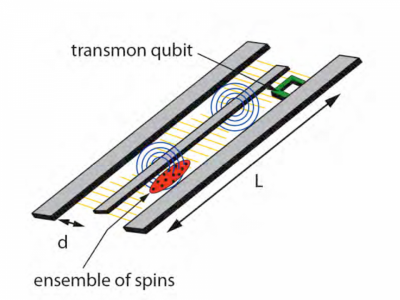WP-4
Hybrid devices and quantum interfaces
Currently, a new focus of research on quantum systems for information technology is emerging that combines the favourable properties of different sub-systems to realize new multi-component devices with enhanced functionality. Such hybrid quantum systems combine the very best properties of different physical implementations, microscopic or macroscopic, to simultaneously explore new regimes of quantum mechanics and to invent new technologies for processing quantum information. Workpackges 1-3 focus on developing specific qubit implementations among the most promising current solid-state systems. These implementations may be of macroscopic nature, such as Josephson or semiconductor circuits, or microscopic-like such as NV centres in diamond. Furthermore, they have rather different characteristics: Josephson qubits are easily controlled but their coherence standard fabrication methods and their spin degrees of freedom have potentially better quantum coherence; NV centers are not easily controlled but have superb quantum coherence.

Using the systems investigated in WP1-3, WP-4 investigates the potential to realise such hybrid quantum systems. One major benefit of this approach is clearly to combine the long coherence times available in solid-state microscopic quantum NV systems with the strong interactions and integration and control possibilities available in macroscopic JJ and QD systems to realize coherent quantum memories, interfaces and larger scale quantum systems. The ultimate challenge, probably beyond SOLID, will be to achieve entanglement transfer between the microwave and optical photonics worlds that would open up for long-distance communication between solid-state hybrid devices. An important application of hybrid systems would be the memory function, for which many of the existing solid state qubits do not provide good solutions, whereas microscopic-like systems, less coupled to the outside world, have a greater potential. The development of other quantum information functions will also be considered, including logic gates for hybrid systems if the “hybrid approaches" investigated perform well.
The primary objectives of WP-4 are:
- To design and experimentally realize microscopic-like quantum systems embedded in microwave resonators: quantum dots in InAs nanowires, quantum wells in nanocavity interfaces, NV centres.
- To design and experimentally realize quantum interfaces for solid-state qubits with microwave photons or optical photons.
- To design and experimentally realize coupling of microscopic solid-state quantum systems to other macroscopic solid-state qubits.
- To design proposals for long-term memory elements in hybrid structures.
- To entangle different kinds of qubits.
- To demonstrate elementary logic gates in hybrid systems.
- To realize a long-lived quantum memory based on nuclear spin ensembles in coupled quantum dot
Workpackage 4 is led by daniel [dot] esteve [at] cea [dot] fr (subject: FROM%20SOLID%20WEBSITE%3A%20RE%3AWP4) (Prof. Daniel Esteve) from Saclay and progress is measured against the the following eight milestones:
- M4.1 Realisation of hybrid systems for quantum information processing on different platforms.
- M4.2 Demonstration of coupling between spin qubits and photonic states (microwave or optical).
- M4.3 Demonstration of coupling between different types of qubits in hybrid structures.
- M4.4 Demonstration of reversible information transfer in a hybrid structure.
- M4.5 Demonstration of a quantum memory in a hybrid structure, evaluation of the storage performance.
- M4.6 Achieve coherent coupling between single NV defect and optical microresonator.
- M4.7 Design of multiqubit-multicavity coupling to achieve quantum information tasks.

